Cave Diving Is Every Bit As Dangerous and Wonderful As It Seems
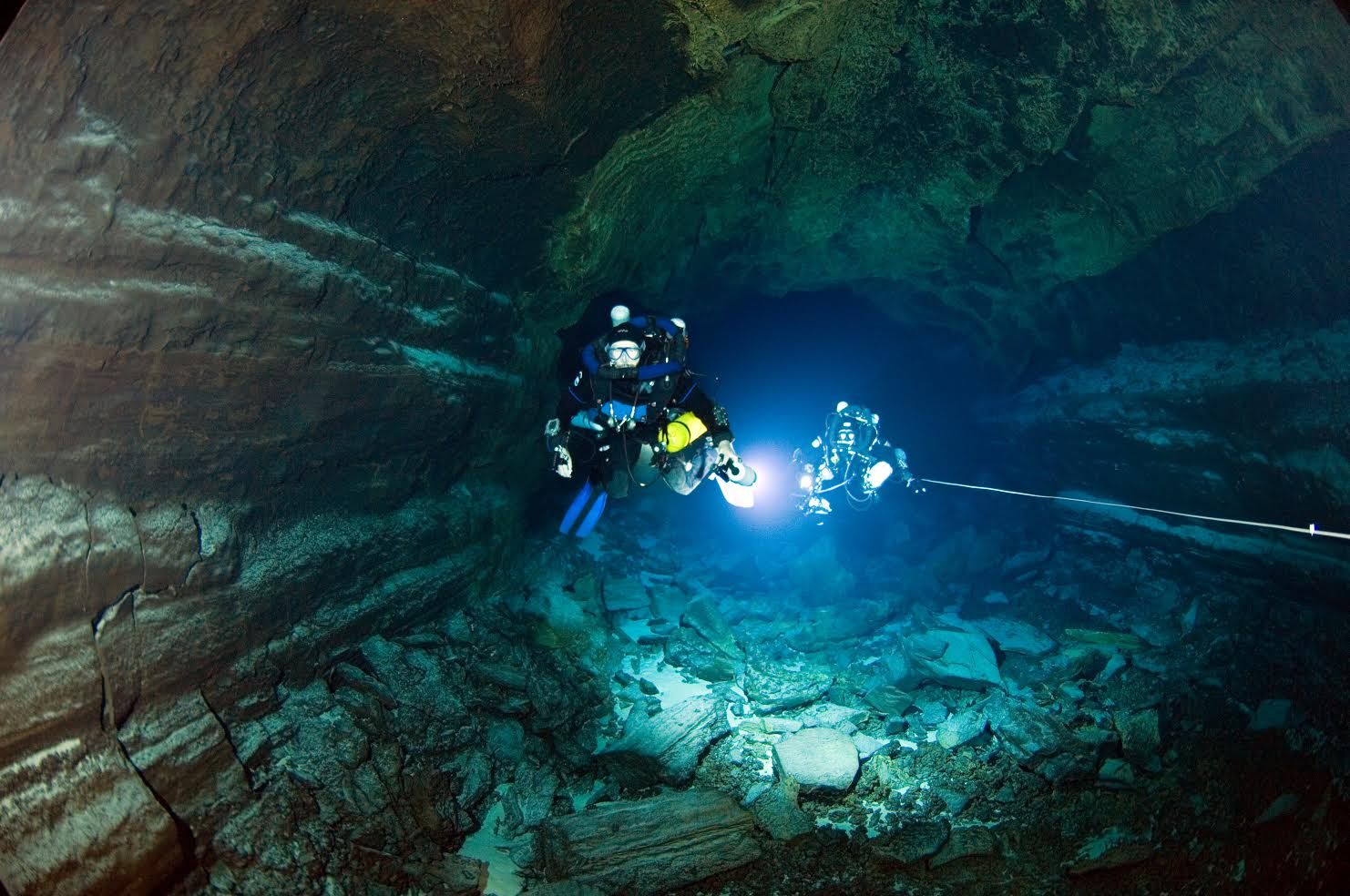
Tom Iliffe diving inside the longest lava tube in the world, known as the Tunnel to Atlantis in Lanzarote, Canary Islands. (Photo: Jill Heinerth/ IntoThePlanet.com)
Huge chunks of the Earth’s surface are not hills or valleys, but pockmarked holes. Humans can only enter a small percentage of these caves and caverns, often at great risk.
And that’s not even counting the secret chambers that are underwater too.
Combining the claustrophobic subterranean thrills of caving, and the perilous aquatic environment of diving, cave diving is one of the more dangerous forms of exploration on the planet. In addition to the threat of running out of air, the chances of getting disoriented and lost in an underwater cave are high for those without the proper training. But for those dedicated and brave enough to descend into the depths anyhow, a world like none other awaits, holding life found nowhere else on the planet.
To descend into the world world of cave diving we spoke with Thomas Iliffe, veteran cave diver, and a professor at Texas A&M specializing in the biodiversity of salt water cave systems. Iliffe has delved into hundreds of caves across the globe, looking for life and adventure. He has worked with both National Geographic and the BBC to bring the wonders of cave diving to the surface. He took the time to give us a glimpse at the fascinating science and danger of exploring the world’s sunken caverns.

Professor Ilife (Photo: Jill Heinerth/ IntoThePlanet.com)
What is your background as a cave diver?
I’ve been a cave diver for probably 40 years now. I’ve been diving in a variety of caves in places around the world. I’m a marine biologist, and my interest is in animals that live in salt water caves in particular.
Were you a cave diver before you became marine biologist or vice versa?
I got my Master’s degree in Oceanography and a P.H.D. in Biochemistry. But my first job was at the Bermuda Biological Station. When I arrived in Bermuda, I’d been doing cave exploration as a hobby up until then. Then I found that there were more than 100 caves within 15 minutes around where I lived. Bermuda’s a small island, and because of that, the caves are not very high above sea level, and you don’t have to go very far into the interior before the caves reached sea level, [and there were] tidal saltwater pools. These pools looked quite deep, with very clear water. Very intriguing.
I got some friends of mine to come over from Florida and teach a cave diving course for myself and several local friends, and we began diving. Down in the deeper waters of the cave you reached a layer of salt water. It was down in this salt water layer that we found all sorts of amazing animals. That was the start of my cave biological research.
Do you call what you do spelunking?
No, spelunking is a term that’s used by people who don’t do that activity. It’s called caving, and a person who does it is called a caver. A person who explores underwater caves is, of course, a cave diver.
If you were to ballpark it, how many caves do you think you’ve explored?
Well over a thousand.
You are usually looking for wildlife, but do you go with a team of people? Geologists or other types of scientists?
Typically, I try to put together a team that has a variety of skills. I try to get one person who is very good at underwater photography, and maybe another person who is very good at the mapping of underwater caves. Then other people who aren’t cave divers to wait on the surface, [so that when we bring up specimens, they can] help sort and identify the material, and examine it while it is still alive. We get a variety of people in our team, each having separate skills or specialties, working particularly on just one job.
What type of wildlife do you usually find down there?
Most of the animals that we see are crustaceans, so relatives of shrimps and crabs and lobster, but much tinier. There’s no light, hence there’s no plants, no photosynthesis, and so the amount of food in the caves is extremely limited. Because the animals tend to be small, they’ve specially adapted to the caves, so they have no pigmentation in general, and reduced or absent eyes.
I’ve done a lot of work in the Canary Islands off the coast of north Africa, where there’s a volcanic cave called the Tunnel to Atlantis. It starts on land in a pool inside a dry cave. But it goes over a mile under the sea floor of the Atlantic Ocean. It gets to a depth of over 200 feet, and has fascinating animals living in it.
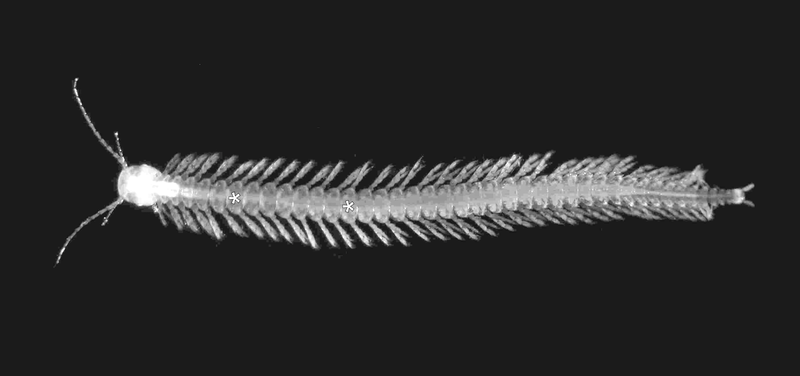
A remipedia. (Image: Wikipedia)
One of the more interesting animals that I’m working with is called remipedia. It looks superficially like a centipede but it’s swimming underwater. It’s actually a type of crustacean. It represents a new class of animals. There’s 27 different species of remipedes known, and something like 17 or 18 of those are from caves in the Bahamas. There are others from areas in the Caribbean, but there’s two from the cave in the Canary Islands, and one from western Australia. Only in salt water caves.
Are most of the creatures you find in caves, exclusive to underwater cave ecosystems?
Yes. For the most part, the animals I’m dealing with are principally found below the halocline. That is the boundary in most of these caves between the fresh or brackish water on the surface, and salt water at depth. Sometimes this boundary layer is so thin, it’s as thin as a sheet of paper, but visually apparent. As you go through it, the water becomes disturbed and everything becomes blurry in front of you as you’re descending through it, but then as you get down to the salt water underneath, everything snaps back into perfect clarity and focus again.
Many of these animals are close to the halocline or just below it. They are feeding on particulate matter that is settling down and landing on this density layer between the fresh and salt water.
We’re doing some work now that indicates that chemosynthesis may be an important process in providing food at the base of these cave food webs. Bacteria can use chemical energy to produce organic compounds that can be food for other animals living in the cave.
Many of the animals we find are not just new species, they are new genera, new families, even new orders. And one new class of crustacean. So they’re new higher groups of animals that have never been seen anywhere else on the planet.
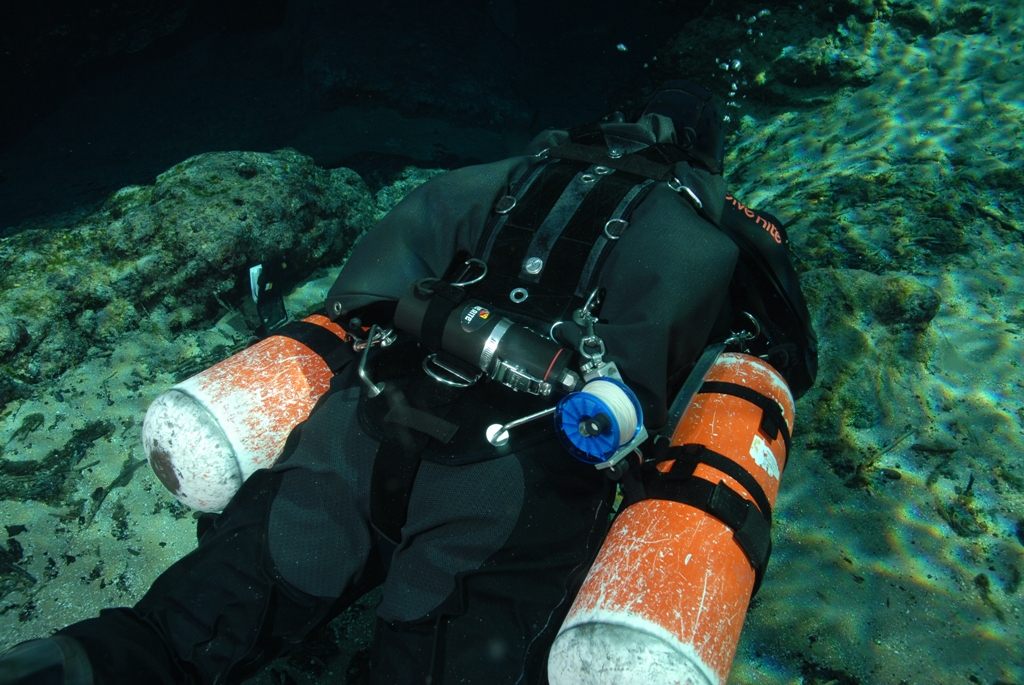
A diver in typical sidemount configuration. (Photo: Pete Nawrocky/Wikipedia)
Could you walk me through the preparation prior to a typical cave dive?
It depends on the caves that we’re diving in. There are a lot of different tools that we use. Most of the time we’re diving with what’s called a “sidemount” configuration. In open water diving, you wear your [air] tanks on your back. In cave diving, often times you have to go through low cracks, so you put your tanks on either side of yourself. You need two tanks because you need redundancy, and a significant air supply. You only use one-third of your gas on the way in at most, and reserve two-thirds for coming back out. If necessary you can even unclip a tank or two and push it in front of you if you have to go through a smaller hole.
On other occasions we use closed circuit rebreathers. That means that all of our exhaled gas is recycled. It goes through a carbon dioxide scrubber that removes the CO2 from our exhaled air, squirts a little more oxygen into it, and we rebreath the same gas, over and over again.
Other than, of course, air, what would you say is the most important piece of equipment no matter what cave you are going into?
Another extremely important piece of gear that we take is a reel [that we use to] lay out a guideline in the cave. The guideline is our means of navigation. We clip little plastic arrows onto the line, and the arrows always point the direction out of the cave. When we reach the furthest point we are going to into the cave we tie off our line and leave it in the cave. The next dive we swim to the end of the line we laid on our previous dive, tie off a new guideline and start going further into the cave.
Is getting lost in the caves a common issue?
If you lose track of which way to go, or which way is out. Maybe your light goes out, or you stir up the sediment in the cave and the visibility essentially goes to zero. You have a limited air supply, so you really only have a few minutes to straighten the problem out, or you’re not going to make it out of the cave.
In general, how deep, or how large are the caves that you explore?
There are some caves in Mexico that we’re exploring, underwater systems that are more than 100 kilometers long. There are multiple entrances into it, but commonly we can be 1,000-2,000 feet away from the nearest entrance. And you’ve got a roof over your head. In open water, you essentially just swim to the surface. But in a cave you can’t do that. You’ve got a rock ceiling, so typically the only way out is back the way you came in.
[Cave diving is especially dangerous] for people who aren’t trained. Proper training and proper equipment are absolutely critical. If you are not properly trained it can literally be a death trap to go into underwater caves. It’s very, very different from diving in open water. There are numerous instances of people who are diving beyond their level of training, going too far or too deep into caves, who have never made it out.

Divers in a cave. (Photo: A bloke called jerm/Flickr)
What are the biggest differences between open diving and cave diving, other than the roof over your head?
Well that’s first. The second is that you’re in perpetual darkness. You have to bring all your own lights. Typically we carry three lights per person, with each light being able to burn for the entire duration of our dives.
Also, you may be going through narrow places in the cave where, if you stir up the sediment or silt along the bottom of the cave, the visibility goes to zero. You may have to put an “okay” signal on the guideline and follow the guideline back out of the cave.
Sometimes some of the caves are quite deep. Half or more of the dives I’ve made in caves are decompression dives. This is when you go down so deep or stay so long that an excess amount of nitrogen builds up in the tissues of your body, and if you ascend too fast, or come to the surface too soon, it’s like shaking shaking up a soda or beer bottle and popping it open. That nitrogen will come fizzing out, inside your body, go straight to your brain, block blood flow to your brain, and that’s all she wrote. So you have to be very careful to have not just enough gas for the dive but for the decompression.
A lot of the work on cave diving procedures was done through accident analysis. That means, unfortunately, looking at fatal diving accidents and saying, ‘What went wrong? What caused these people to die?’
There are five rules that were developed as a result of this. The first is, have proper training. The second is, have a guideline. Third, reserve enough air. Fourth, have proper lights. And fifth is, don’t go too deep.
How deep is too deep? Is there a point where things become especially dangerous?
Yes, but you can get around those problems by having appropriate gas mixtures. With compressed air, you are limited to safe depths around 130 feet. If you’re going significantly deeper than that, you have to switch to trimix. Trimix is a mixture of helium, nitrogen, and oxygen. You lower the amount of oxygen and nitrogen in your breathing mixture and replace it with helium, which is an inert gas. That allows you to go deeper, safer.
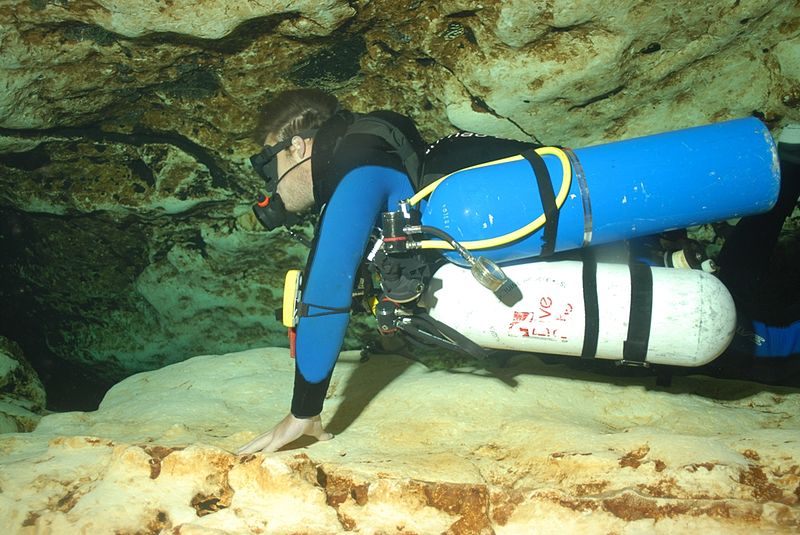
Things can get a little tight. (Photo: Pete Nawrocky/Wikipedia)
What is the most treacherous experience you’ve had while cave diving?
First of all, we try and be really safe. Safety is paramount. I probably wouldn’t be here if I was doing a lot of ultra-risky types of dives.
But I was diving one time in a cave in the mountains of northern Mexico. You had to rappel down on a rope about 50 feet or more to reach the water level in this cave. There had already been another diver who went down a few minutes in front of me and laid a line. He said he got down to over 100 feet and then the cave pinched out.
I started following the line down, but his bubbles had knocked off particles from the ceiling of the cave, and even if you have proper technique, your bubbles can cause a lot of silt or sediment to drop into the water and greatly reduce visibility. So I could only see a foot or two around me. I followed the line down to about 80 feet or so and the cave started to get smaller on me.
At that point I decided to turn around, and as I turned around, one of my tanks caught on the guideline and pulled it. It caused a boulder above me that the line was wrapped around to come crashing down. That totally destroyed any visibility that was there, and wiped out the guideline.
I thought I had been coming straight down this crack, and I started going straight up. As I ascended, I got to a depth of about 40 feet and the crack got too small to continue. So I went down 20-30 deeper, went over about 15-20 feet, and came up again. This time I got to about 20 feet, but again the crack pinched out. So I went down one more time, went over another 15-20 feet, and came back up. This time I got back to the pool where I started.
Fortunately all this happened at the beginning of the dive, and because of that I still had a lot of air, but my heart was beating pretty good at the end of that dive.
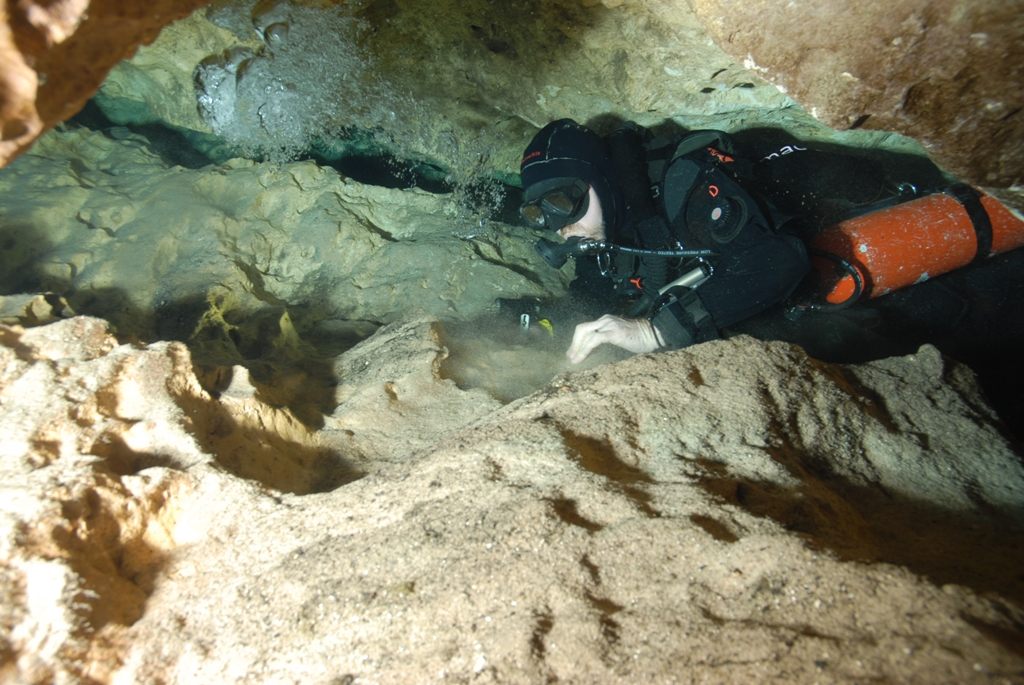
Watch those bubbles. (Photo: Pete Nawrocky/Wikipedia)
What do you think the difference is between when you go on research dives and recreational cave diving?
Being a scientific cave diver adds a whole other facet to it. Because one of the main problems in cave diving that I haven’t mentioned yet is something called “task loading.” There’s a number of things you have to do during the dive. Any one of these is very, very easy, but when you have to do 8 or 10 or 12 things simultaneously, even though they are individually easy to do, doing all of them becomes very difficult. You have to watch your buddy.
You have to see where the guideline is. You have to check the visibility. You have to check your depth. You have to check your time underwater. You have to check your gas pressure to make sure you’ve got enough air. You have to make sure you’re within the no decompression limits. You have to check with you buddy using light signals. All of these are easy to do, but they become progressively more difficult, especially if any emergency situations develop.
Then in scientific diving, you’ve got to do all of those things, plus you have scientific tasks that you’ve got to carry out, whether it’s looking for animals or collecting water samples, or sediment samples. Carrying electronic water quality instruments that measure the depth, temperature, salinity, PH, dissolved oxygen levels, etc. We try to do only one major scientific task at a time on a dive, just so we don’t get overloaded.
Do you still do recreational cave diving?
Sure. For example, I have a friend of mine who was big on diving on coral reefs, and open water diving. Every weekend he would be out diving on the reefs or on a shipwreck or something like that. Then I got him interested in cave diving. He started cave diving with me all the time. One time I said, “You know I notice you haven’t been going out diving on the coral reefs or shipwreck diving anymore.” and he said, “Yeah, when I go out do those dives I get bored really quickly. But I can dive the same cave 20 or 30 or 40 times in a row and I never get the slightest bit bored.”
Cave diving is something that’s not for everyone. It takes the right type of person to be able to do it, and do it safely, and enjoy it. But it can be very addictive.
Do people get jealous of your job?
Sometimes my students tease me that I’ve got the best job ever.
What advice would you give to someone who wanted to get into cave diving?
First is to become experienced in open water diving. I would recommend having 50, preferably 100 open water dives done before you even consider doing cave diving. Then take a cave diving course. Find a good instructor and go through a rigorous course in cave diving.
So, train, train, train, is what you’re saying.
And then have the right equipment.













Follow us on Twitter to get the latest on the world's hidden wonders.
Like us on Facebook to get the latest on the world's hidden wonders.
Follow us on Twitter Like us on Facebook